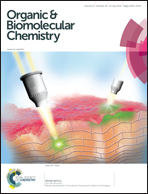19F NMR monitoring of the eukaryotic 20S proteasome chymotrypsin-like activity: an investigative tool for studying allosteric regulation†‡
Abstract
The proteasome displays three distinct proteolytic activities. Currently, proteasome inhibitors are evaluated using specific fluorescent substrates for each of the individual active sites. However, the photophysical properties of the commonly used fluorophores are similar and thus, the simultaneous monitoring of the three proteolytic activities is not possible. We have developed a bimodal fluorescent fluorinated substrate as a novel tool to study the chymotrypsin-like (ChT-L) proteolytic activity and its regulation by inhibitors and by substrates of trypsin-like (T-L) and caspase-like sites (PA). We demonstrate that this substrate is reliable to evaluate the ChT-L inhibitory activity of new molecules either by fluorescence or 19F NMR spectroscopy. We have found that the ChT-L activity is dramatically reduced in the presence of T-L and PA substrates. This work provides a proof of concept that the fluorinated substrate enables investigation of the allosteric regulation of the ChT-L activity.


 Please wait while we load your content...
Please wait while we load your content...